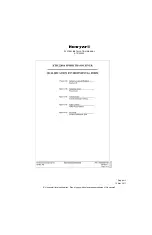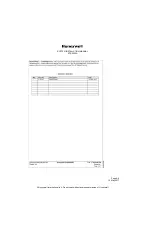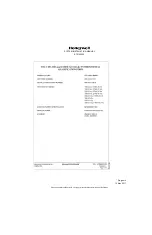
SYSTEM INSTALLATION MANUAL
KTR 2280A
Page 2-46
15 May 2017
© Honeywell International Inc. Do not copy without express permission of Honeywell.
2.4.1.2 Ground Tests
(1) Post-Installation Test (NAV/COM Functionality)
Perform a ground check of the installation before the flight test. Using a local frequency, confirm
that the COM function can receive and transmit a modulated signal. Using a ramp tester, con-
firm that VOR, LOC, and GS needle deflections move in the correct direction, the To/From flag
is the proper sense, and that the warning flags are functioning properly. Check all aircraft con-
trol movements to be sure no electrical cables interfere with their operation.
CAUTION: AS AN ADDED PRECAUTION BEFORE ANY FLIGHT TESTS, CHECK THE ANTENNA.
VSWR MUST BE CHECKED WITH AN IN-LINE TYPE WATTMETER INSERTED IN THE
COAXIAL TRANSMISSION LINE BETWEEN THE TRANSCEIVER AND THE ANTENNA. ANY
PROBLEM WITH THE ANTENNA INSTALLATION WILL MOST LIKELY BE SEEN AS A HIGH
REFLECTED POWER.
NOTE: Installed system transmitter power may show considerably less that the manufacturer’s rating of
16 W (minimum). There are several reasons for this:
1. It is not uncommon for an installation to have up to as much as 1 dB of RF transmission
line cable loss. This would reduce a 16 W transmitter output to 12.7 W.
2. RF power meter test equipment that has an accuracy of ± 0.3 dB would cause power
reading variations as high as ± 1 W.
3. The effect of antenna VSWR in a given installation will affect the output power. The
VSWR is a function of the antenna design itself, aircraft skin properties and proximate
metallic features of the airframe, and the size of the metallic surface the antenna is
bonded to. Note that the committees that wrote the Minimum Operation Performance
Standards to which the VHF COM system is TSO’d are aware of this characteristic.
They have established that transmitter power for a 16 W (minimum) transmitter must
not drop below 8.0 W into a 2:1 VSWR and 6.4 W into a 3:1 VSWR (Refer to RTCA-
DO-186B and Eurocae ED-23C).
(2) Post-Installation Test (ADF Functionality)
A quick preliminary check can be made by tuning to a local AM broadcast station or a strong
NDB station. Check for satisfactory audio (this must be done where clear reception is possible,
preferably outside of the hangar).
(a) Quadrantal Error Adjustments
The system has been factory adjusted to compensate for a typical airframe. Therefore,
little or no compensation must be required. Nonetheless, the KTR 2280A provides soft-
ware adjustment of Quadrantal Error (the average amount of quadrantal error (QE) that
exists due to the shape of the airframe). The values for these alignments are stored
within the aircraft system maintenance computer and downloaded to the KTR 2280A
on power up. If this download does not occur the KTR 2280A uses the last values that
were loaded.
The KA 44B ADF antenna, like most modern ADF antennas, can have inherent errors
at the quadrantal (45
°
, 135
°
, 225
°
and 315
°
) bearings relative to the antenna’s boresite.
The following procedure details the process for setting a KTR 2280A configuration pa-
rameter to allow the radio to automatically compensate for these inherent errors. It is
very important that this procedure be followed exactly as stated to ensure these qua-
drantal bearings are properly compensated.
This procedure can be carried out at any location, however care must be exercised to
ensure that the chosen location is magnetically “clean”. Usually an airfield’s compass
















































